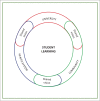Decentralised training for medical students: Towards a South African consensus
- PMID: 29041802
- PMCID: PMC5645562
- DOI: 10.4102/phcfm.v9i1.1449
Decentralised training for medical students: Towards a South African consensus
Abstract
Introduction: Health professions training institutions are challenged to produce greater numbers of graduates who are more relevantly trained to provide quality healthcare. Decentralised training offers opportunities to address these quantity, quality and relevance factors. We wanted to draw together existing expertise in decentralised training for the benefit of all health professionals to develop a model for decentralised training for health professions students.
Method: An expert panel workshop was held in October 2015 initiating a process to develop a model for decentralised training in South Africa. Presentations on the status quo in decentralised training at all nine medical schools in South Africa were made and 33 delegates engaged in discussing potential models for decentralised training.
Results: Five factors were found to be crucial for the success of decentralised training, namely the availability of information and communication technology, longitudinal continuous rotations, a focus on primary care, the alignment of medical schools' mission with decentralised training and responsiveness to student needs.
Conclusion: The workshop concluded that training institutions should continue to work together towards formulating decentralised training models and that the involvement of all health professions should be ensured. A tripartite approach between the universities, the Department of Health and the relevant local communities is important in decentralised training. Lastly, curricula should place more emphasis on how students learn rather than how they are taught.
Conflict of interest statement
The authors declare that they have no financial or personal relationships that may have inappropriately influenced them in writing this article.
Figures





Similar articles
-
Outcomes of Australian rural clinical schools: a decade of success building the rural medical workforce through the education and training continuum.Rural Remote Health. 2015 Jul-Sep;15(3):2991. Epub 2015 Sep 16. Rural Remote Health. 2015. PMID: 26377746
-
James Cook University's decentralised medical training model: an important part of the rural workforce pipeline in northern Australia.Rural Remote Health. 2016 Jan-Mar;16(1):3611. Epub 2016 Mar 19. Rural Remote Health. 2016. PMID: 26992830
-
Medical education, reflections and perspectives from South Africa: a review.BMC Med Educ. 2025 Mar 12;25(1):370. doi: 10.1186/s12909-025-06910-8. BMC Med Educ. 2025. PMID: 40075353 Free PMC article. Review.
-
Cuban medical training for South African students: a mixed methods study.BMC Med Educ. 2019 Jun 17;19(1):216. doi: 10.1186/s12909-019-1661-4. BMC Med Educ. 2019. PMID: 31208423 Free PMC article.
-
Decentralised training for medical students: a scoping review.BMC Med Educ. 2017 Nov 9;17(1):196. doi: 10.1186/s12909-017-1050-9. BMC Med Educ. 2017. PMID: 29121923 Free PMC article.
Cited by
-
Perceptions of postgraduate family medicine supervision at decentralised training sites, South Africa.Afr J Prim Health Care Fam Med. 2022 Mar 14;14(1):e1-e13. doi: 10.4102/phcfm.v14i1.3111. Afr J Prim Health Care Fam Med. 2022. PMID: 35384683 Free PMC article.
-
The Durban University of Technology Faculty of Health Sciences Decentralized Clinical Training Project: Protocol for an Implementation Study in KwaZulu-Natal, South Africa.JMIR Res Protoc. 2024 Jun 3;13:e52243. doi: 10.2196/52243. JMIR Res Protoc. 2024. PMID: 38829695 Free PMC article.
-
Clinical educator's experiences of the decentralised training platform for Occupational Therapy students in KwaZulu-Natal, South Africa.Afr Health Sci. 2021 Dec;21(4):1941-1949. doi: 10.4314/ahs.v21i4.53. Afr Health Sci. 2021. PMID: 35283941 Free PMC article.
-
Faculty development for supervisors of medical student rural attachments in Zimbabwe.Afr J Prim Health Care Fam Med. 2024 Sep 24;16(1):e1-e4. doi: 10.4102/phcfm.v16i1.4641. Afr J Prim Health Care Fam Med. 2024. PMID: 39501867 Free PMC article.
-
Graduate perceptions of their interprofessional practice: Lessons for undergraduate training.Afr J Prim Health Care Fam Med. 2024 Dec 18;16(1):e1-e12. doi: 10.4102/phcfm.v16i1.4706. Afr J Prim Health Care Fam Med. 2024. PMID: 39846109 Free PMC article.
References
-
- World Health Organization Scaling up, saving lives: Task force for scaling up education and training for health workers [homepage on the Internet]; 2008. [cited 2017 Mar 01]. Available from: http://www.who.int/workforcealliance/documents/Global_Health%20FINAL%20R...
-
- Celletti F, Reynolds T, Wright A, Stoertz A, Dayrit M. Educating a new generation of doctors to improve the health of populations in low- and middle-income countries. PLoS Med. 2011;8(10):e1001108 https://doi.org/10.1371/journal.pmed.1001108 - DOI - PMC - PubMed
-
- World Health Organization Transforming and scaling up health professionals’ education and training: World Health Organization guidelines. Geneva: World Health Organization; 2013. [cited n.d.]. Available from: http://www.who.int - PubMed
-
- Frenk J, Chen L, Bhutta ZA, et al. . Health professionals for a new century: Transforming education to strengthen health systems in an interdependent world. Lancet. 2010;376(9756):1923–1958. https://doi.org/10.1016/S0140-6736(10)61854-5 - DOI - PubMed
-
- Berwick DM, Finkelstein JA. Preparing medical students for the continual improvement of health and health care: Abraham Flexner and the new ‘public interest’. Acad Med. 2010;85(9 Suppl):S56–S65. https://doi.org/10.1097/ACM.0b013e3181ead779 - DOI - PubMed
MeSH terms
LinkOut - more resources
Full Text Sources
Other Literature Sources
